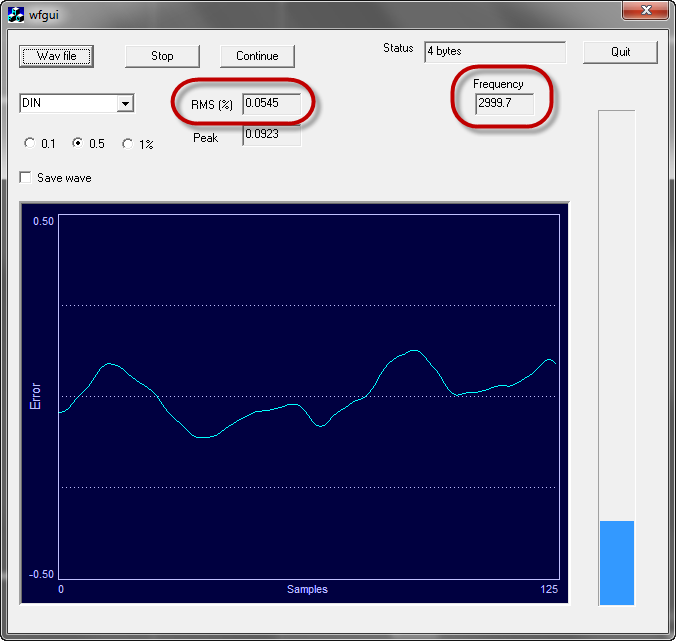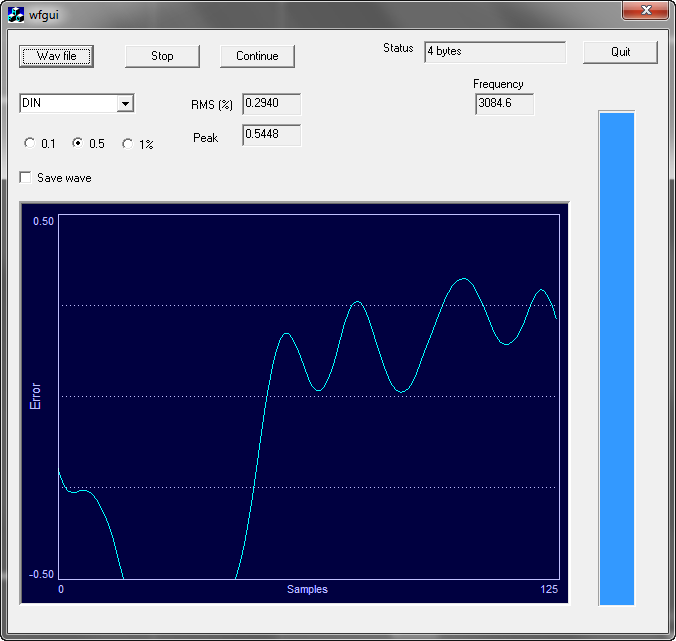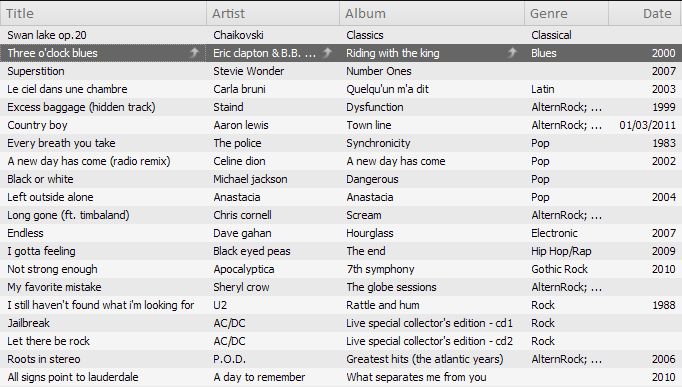|
Stereo crosstalk
This value measures the separation between both channels (right and left). The better the amplifier and the whole circuitry, the lower the crosstalk, which leads in a better separation of both channels. This can be specially felt when listening to music with spazialization, like live recordings.
Wow&Flutter
One of the most important things to check in a tape player is, apart from previous stuff, the wow and flutter, which the audible oscillation of playing speed both at very low frecuency (wow, about 4Hz) and reasonably high frecuency (flutter, about 200Hz).
This measurement is often calculated in various standards, while DIN is one of the most common, and the one I choosed for my tests.
For measuring it I recorded and 3kHz signal with my modded 'superD6C', which has very low wow&flutter. Then I play the tape on the walkman to be measured while recording it to a mono, uncompressed (PCM WAV) file and load it in the wow&flutter measuring software (thanks to stereo2go's intell2000 user):

The wow&flutter measurement on my modded 'Super D6C' shows an surprinsingly low value of only 0,05%,
which is almost better than many high-end decks. This software also shows the average frecuency measured,
which in this case is 2999.7 Hz, almost the same 3000Hz recorded.
Just to confirm, let's see how the budget SONY B39 performs:

The
SONY B39, that doesn't have any advanced transport system (like the quartz-locked disc drive of the D6C)
shows a value of 0,29%, which is normal for such a mid-level walkman.
As you can see the 'Super D6C' has about 0,05% of w&f while the B39, almost 0,30%, which is 5 times more. That's a lot, indeed.
But... how does it feel? what's the real difference between an excellent and a poor wow&flutter? Let's see real examples:
This is a real example of a plain high tone (3000 Hz to be exact) carefully recorded on an excellent tape (SONY UX Pro, last generation) played on a Panasonic RQ-P525, a high-class walkman (which features Dolby C). This walkman has a high w&f, worsened by some kind of problem in the roller:
and this one is the same tape played on a SONY TC-D5 Pro, one of the best portable machines ever built, very close to the superb D6C, and even better in some aspects. This state-of-the-art portable player has a w&f of only 0,037% (even less than my 'Super D6C'!):
As you can hear, the difference is huge.
Subjective audio measurement
The second part of my audio analysis has to be non-technical. After reading some reviews in very respectable websites, like Innerfidelity, I decided that I'll perform a mixed set of test: both technical (objective) and the next one, completely subjective. I've often read by reviewers that they don't have a fixed set of songs to test always the same way, but a few songs here and there.
But I wanted something more serious, so I started a few months ago to slowly select songs I like that have something interesting that allows me to extract anything interesting from a player.
So I made a 12-minute mix specially done to allow a wide variety of styles to test any music device. From classical to hard rock, through disco, '80s pop, vocal, live or electronic. From Chaikovsky to AC/DC, through Eric Clapton, Celine Dion, Chris Cornell or U2.
The mix is made to allow testing of:
- Dynamic range
- Soundstage,
- Many kinds of bass, through those found in Blues to electronic or disco
- Voice, both isolated (man and woman), smooth, broken, etc...
- Guitar (acoustic, electric, heavily distorted...)
- Surround effects (like in 'Black or white' from Michael Jackson)
- Live recordings (U2, AC/DC)
Here it is the song list, sorted in order of appearance:

To make this mix, I selected carefully every song from a big list, then I extracted them from CD (without compression) or downloaded (at with very high bitrate or lossless) and mixed in a professional-grade software, then exported in a WAV file (no compression at all).
All them were normalized to the same level. Here it is:
So this is a true wide style music style that allows a thorough test of the audio response of a music player in too many different scenarios.
You can download it, experiment with it as much as you want.
NOTE: I detected heavy audio processing in
this Soundcloud files. Looks that they apply some kind of loudness or dynamic compression to the audio. If you really want to hear the real file, please download it and play it in a good media player.
For testing walkmans, I recorded this mix on a UX Pro using my 'Super D6C' toghether with the rest of objective test, so I can quickly review a player.
Performing a real analysis
So finally, to measure a Walkman, I proceed like this:
| 1) |
Take the walkman to a professional repairing service. For the common faults (belts, dead capacitors) I take them to a professional (official) SONY and AIWA technician here in Barcelona. This man has been working as an external technicial for both SONY and AIWA for 30 years. |
| 2) |
Put the reference tape on it. The first step is -if it's possible- to adjust the Azimuth following precise intructions from Dr Walkman. |
| 3) |
Then I adjust the maximum output level to 0dB in the line input of the sound card and check that it doesn't suffer from clipping. I do this using a 1kHz sine signal. |
| 4) |
Once adjusted the output level properly, I play and record a 3kHz signal for 15" to measure wow&flutter. |
| 5) |
Play the full RMAA audio test, to measure all its characteristics. |
| 6) |
Measure the frequency response curve (FRC) using pink noise recorded on a SONY UX Pro tape and TrueRTA analysis software. The measure is done at +3, 0, -10 and -20 dB. |
| 7) |
Measure the FRC with and without dolby systems. |
| 8) |
If the player has a built-in EQ, measure the FRC of every slider of the EQ set to maximum value. |
| 9) |
Measure the background noise with and without Dolby in TrueRTA analysis software. |
| 10) |
Play the subjective 12-minute mix to get a subjective impression of how it sounds. |
And that's all!
Want to know how do I put all this info in a particular walkman review? Continue to this article to see it.
|
![]()
![]()
![]()
